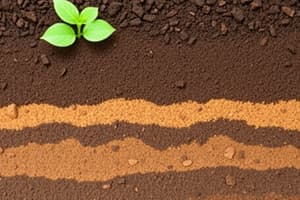Podcast
Questions and Answers
What is the primary characteristic of the O-Horizon layer of soil?
What is the primary characteristic of the O-Horizon layer of soil?
- High in nutrients for plant growth
- Contains coarse grains
- Rich in clay minerals
- Consists of decaying plant material and microorganisms (correct)
Which soil layer is crucial for water retention and root penetration?
Which soil layer is crucial for water retention and root penetration?
- C-Horizon
- A-Horizon
- E-Horizon
- B-Horizon (correct)
What is the primary characteristic of the Silt soil type?
What is the primary characteristic of the Silt soil type?
- Fine grains and rich in nutrients (correct)
- Coarse grains and well-drained
- Excellent water retention
- Ultra-fine grains and slow to drain
Which soil type is characterized by being low in nutrients but well-drained?
Which soil type is characterized by being low in nutrients but well-drained?
In terms of soil layers, what is the function of the E-Horizon?
In terms of soil layers, what is the function of the E-Horizon?
Which layer is considered as the foundation of ecosystems due to its mixture of minerals, organic matter, water, and living organisms?
Which layer is considered as the foundation of ecosystems due to its mixture of minerals, organic matter, water, and living organisms?
Which component of soil composition provides the space between soil particles for air, water, and root penetration?
Which component of soil composition provides the space between soil particles for air, water, and root penetration?
What is the main threat to the health of ecosystems and agriculture as mentioned in the text?
What is the main threat to the health of ecosystems and agriculture as mentioned in the text?
Which practice involves changing the type of crops planted in a field to help replenish soil nutrients?
Which practice involves changing the type of crops planted in a field to help replenish soil nutrients?
What type of soil erosion involves the movement of soil by water?
What type of soil erosion involves the movement of soil by water?
Which component of soil composition includes living organisms that break down organic matter and recycle nutrients?
Which component of soil composition includes living organisms that break down organic matter and recycle nutrients?
What is the main purpose of contour farming as a soil conservation practice?
What is the main purpose of contour farming as a soil conservation practice?
Study Notes
Soil: Understanding Earth's Foundation
Soil is more than just a medium for growing plants; it's a complex mixture of minerals, organic matter, water, and living organisms that forms the foundation of our ecosystems. Let's delve into the layers, types, composition, and the challenges of preserving this vital resource.
Soil Layers
Soil is not uniform, but rather, is typically organized into several distinct layers:
- O-Horizon (Organic layer): A thin layer of decaying plant material, humus, and microorganisms.
- A-Horizon (Topsoil): Rich in organic matter, nutrients, and microorganisms, this layer supports plant growth.
- E-Horizon (Eluviation layer): This layer may contain fewer nutrients and is lighter in color due to the leaching of clay and nutrients.
- B-Horizon (Subsoil): A mixture of clay, silt, and sand, containing fewer nutrients than the A-Horizon, but is essential for water retention and root penetration.
- C-Horizon (Parent material): The deepest layer, composed of unweathered rock or minerals, which solidified to form soil in the upper layers.
Types of Soil
Soil can be classified based on its texture, color, and structure. Common soil types include:
- Sand: Coarse grains, well-drained, and low in nutrients
- Silt: Fine grains, easily compacted, and rich in nutrients
- Clay: Ultra-fine grains, slow to drain, but excellent water retention
- Loam: A combination of sand, silt, and clay, providing good drainage and nutrient retention
Soil Composition
Soil is composed of five main components:
- Solid matter: Rocks and minerals, as well as organic matter (humus and plant material)
- Liquid matter: Water, which is essential for plant growth and nutrient uptake
- Gaseous matter: Nitrogen, carbon dioxide, and other gases that contribute to plant growth and soil processes
- Biological matter: Living organisms such as bacteria, fungi, and earthworms, which break down organic matter and recycle nutrients
- Porosity: The space between soil particles that allows for air, water, and root penetration
Soil Erosion
Soil erosion is a significant threat to the health of ecosystems and agriculture. Erosion can occur naturally or as a result of human activities. Some forms of erosion include:
- Water erosion: The movement of soil by water, such as runoff or streambank erosion
- Wind erosion: Soil particles are blown away by the wind
- Cultivation erosion: Soil displacement resulting from farming practices
Soil Conservation
Soil conservation aims to protect and improve soil quality to ensure its long-term productivity and sustainability. Some soil conservation practices include:
- Crop rotation: Changing the type of crops planted in a field, which helps to replenish soil nutrients
- No tillage: Reduces soil disturbance, minimizing soil erosion and nutrient loss
- Contour farming: Planting crops in lines that follow the natural contours of the land, reducing water runoff and preventing erosion
- Cover crops: Planting non-crop species to protect the soil, reduce erosion, and improve soil fertility
Understanding these subtopics allows us to appreciate the complexity of soil, and its crucial role in sustaining life. By implementing soil conservation practices and understanding soil composition, we can ensure the longevity and productivity of our ecosystems.
Studying That Suits You
Use AI to generate personalized quizzes and flashcards to suit your learning preferences.
Description
Test your knowledge on soil layers, types, composition, erosion, conservation practices, and the vital role of soil in ecosystems. Explore the characteristics of different soil layers, types, and the methods to preserve this essential resource.




